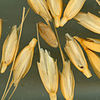- Chaff
-
Chaff (
 /ˈtʃɑːf/[1] or /ˈtʃæf/) is the dry, scaly protective casings of the seeds of cereal grain, or similar fine, dry, scaly plant material such as scaly parts of flowers, or finely chopped straw. Chaff is inedible for humans, but livestock can eat it and in agriculture it is used as livestock fodder, or is a waste material ploughed into the soil or burnt.
/ˈtʃɑːf/[1] or /ˈtʃæf/) is the dry, scaly protective casings of the seeds of cereal grain, or similar fine, dry, scaly plant material such as scaly parts of flowers, or finely chopped straw. Chaff is inedible for humans, but livestock can eat it and in agriculture it is used as livestock fodder, or is a waste material ploughed into the soil or burnt.Contents
Etymology
"Chaff" comes from Middle English chaf, from Old English ceaf, related to Old High German cheva, "husk".
Grain chaff
In grasses (including cereals such as rice, barley, oats and wheat), the ripe seed is surrounded by thin, dry, scaly bracts (called glumes, lemmas and paleas), forming a dry husk (or hull) around the grain. Once it is removed it is often referred to as chaff.
In wild cereals and in the primitive domesticated einkorn,[2] emmer[3] and spelt[4] wheats, the husks enclose each seed tightly. Before the grain can be used, the husks must be removed.
The process of loosening the chaff from the grain is called threshing – traditionally done by milling or pounding. Separating the loose chaff from the grain is called winnowing – traditionally done by tossing grain up into lightly blowing wind, dividing it from the lighter chaff, which is blown aside. This process typically utilizes a broad, plate-shaped basket, or similar receptacle for holding and collecting the winnowed grain as it falls back down.
Domesticated grains such as durum wheat and common wheat have been bred to have chaff which is easily removed. These varieties are known as free-threshing or naked.
Chaff should not be confused with bran, which is finer scaly material forming part of the grain itself.
Straw chaff
Chaff is also made by chopping straw (or sometimes coarse hay) into very short lengths, using a machine called a chaff cutter. Like grain chaff this is used as animal feed, and is a way of turning coarse fodder into a form more palatable to livestock.[5][6][7]
Botany
In botany, chaff refers to the thin receptacular bracts of many species in the sunflower family Asteraceae and related families. They are modified scale-like leaves surrounding single florets in the flower-head.
Metaphor
Chaff as a waste product from grain processing leads to a metaphorical use of the term, to refer to something seen as worthless. This is commonly used in the expression "to separate the wheat from the chaff" from Matthew 3., where it means to separate things of value from things of no value. Another example is in Psalm 1 of the Bible, which says: "Not so the wicked! They are like chaff that the wind blows away".
See also
References
- ^ Oxford English Dictionary, Oxford University Press, 1933: Chaff
- ^ Potts, D. T. (1996) Mesopotamia Civilization: The Material Foundations Cornell University Press. p. 62. ISBN 0-8014-3339-8.
- ^ Nevo, Eviatar & A. B. Korol & A. Beiles & T. Fahima. (2002) Evolution of Wild Emmer and Wheat Improvement: Population Genetics, Genetic Resources, and Genome.... Springer. p. 8. ISBN 3-540-41750-8.
- ^ Vaughan, J. G. & P. A. Judd. (2003) The Oxford Book of Health Foods. Oxford University Press. p. 35. ISBN 0-19-850459-4.
- ^ "The Chaff cutter"
- ^ Cutting chaff by hand: detail of painting by David Teniers the Younger
- ^ A Victorian chaff cutter
Categories:
Wikimedia Foundation. 2010.


